
Catalog excerpts
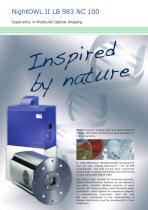
NightOWL II LB 983 NC 100 Superiority in Molecular Optical Imaging red pi ns I re tu na by Bioluminescence imaging (BLI) and biofluorescence imaging (BFI) allow monitoring of gene expression in living organisms. In 1989 BERTHOLD TECHNOLOGIES introduced its first low light imaging instrument – the LB 980 Luminograph. The first in-vivo gene expression experiments in plants and animals were performed on this instrument before 1993. BLI utilizes light emitted by luciferase enzymes. Today bioluminescence markers can be tailored to any gene, enabling detailed research of gene function. BFI...
Open the catalog to page 2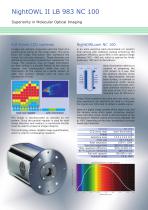
Images are optically projected onto the front of a parallel array acting as the image plane. The array takes the image information and partitions the image into discrete elements. Those elements are defined by the number of pixels thus "quantizing" the image. The resulting rows of image information are then shifted in a parallel fashion to the readout register that subsequently shifts the row of information to the output as a serial stream of data. The process repeats until all rows are transferred off chip. The image is reconstructed as dictated by the system. Since the parallel register...
Open the catalog to page 4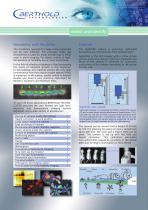
The conditions required to image living organisms can be very different. For example, today gas anaesthesia is used for small animals but is never used in plant imaging. For plants control of light, temperature or humidity are of more importance. The NightOWL cabinet is extremely light-tight preventing any interferences from ambient light. In the field of infectious diseases or food processing the study of bacterial growth is the objective. In dermatology and material science the very faint luminescence from free radical oxygen species (ROS) is measured. In life science, quality control or...
Open the catalog to page 5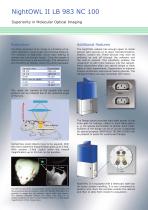
NightOWL II LB 983 NC 100 Superiority in Molecular Optical Imaging Additional features The total resolution of an image is a function of camera resolution, focal length and working distance. The software of NightOWL allows easy setting of sample size and sample height. Once the sample is defined the focus is set accordingly. The resolutions are therefore as follows, shown by some examples: The NightOWL cabinet has enough space to install special light sources or to place transilluminators, heaters, coolers etc. These devices may even be switched on and off through the software and the...
Open the catalog to page 6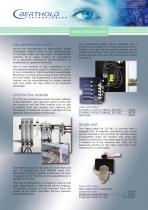
detect and identify Gas anaesthesia units During the luminescence or fluorescence image acquisition rodents have to be anaesthesized. In principle, there are two ways: intraperitoneal injection of a liquid mixture of anaesthesia (e. g. ketamine / xylazine or tribromoethanol) or anaesthesia by gaseous isoflurane. One of the benefits of gas anaesthesia is an increased luminescent signal in rodents by a factor of two compared to tribromoethanol anaesthesia. Breathing is normal, blood pressure and ATP levels are more stable. Gas anaesthesia is less harmful, so rodents can be anaesthesized for...
Open the catalog to page 7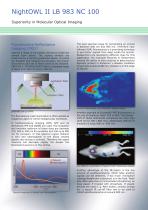
NightOWL II LB 983 NC 100 Superiority in Molecular Optical Imaging Fluorescence Reflectance Imaging (FRI)* requires a range of illumination devices to excite the sample from above. The signals emitted are measured by a camera positioned above. To excite the fluophor and measure its emission, the proper illumination and set of filters have to be choosen. BERTHOLD TECHNOLOGIES offers a complete range of filters from 340 nm up to 1100 nm. The best spectral range for penetrating an animal is between 600 nm and 900 nm. Therefore near infrared (NIR) fluorescence is a promising technique to get...
Open the catalog to page 8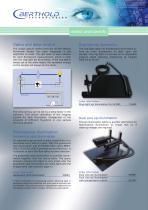
Optics and lamp control The unique optical system from the LB 940 Mithras Multimode Reader has been integrated in the NightOWL II model. The light beam is kept constant for each fluorescent measurement, which is ideal with the ring-light epi illumination. If the ring-light is always set at the same height, the excitation energy on the sample will always be the same. The ring-light option for fluorescence illumination allows an even distribution of light upon the sample. The ring-light is mounted on an adjustable support stand allowing positioning at heights from 14 to 16 cm. Order...
Open the catalog to page 9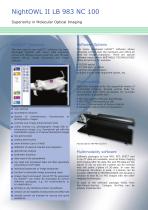
indiGOTM Software The new easy-to-use indiGOTM software has been developed together with users. Well organized menus and dialogue boxes guide the user through camera set-up, image processing and image analysis. user defined quantitative analysis display of luminescence, fluorescence or photographic images contrast and image enhancement tools colour overlay e.g. photographic image with luminescence image, e.g. fluorescent gel with the hybridization signal, or of various fluorescent images line plot function surface plot function zoom function (up to 5-fold) definition of areas of interest...
Open the catalog to page 10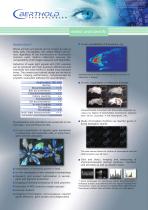
In-vivo visualization of fluorophors, e.g. Whole animals and plants can be imaged as well as blots, gels, microplates, cell culture dishes and arrays regardless of the luminescent or fluorescent markers used. Optical calibration ensures the comparability of all images captured with NightOWL. Detection of weak light signals with CCD cameras can be achieved with high quantum efficiencies and extremely low noise levels to enable long exposure times. The camera and cabinet design are the key to superior imaging performance, complemented by scientific evaluation software for quantification....
Open the catalog to page 11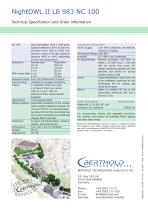
Resolution Sample size Resolution With macro table 2 cm 20 ^m NC 100 back illuminated, 1024 x 1024 pixel, quantum efficiency 90 % at 620 nm, sensitive from 300 to 1050 nm, dynamic range of 90 dB, cooling to absolute -80°C to -90°C depending on the room temperature. Exposure times from 30 milliseconds to hours Pixel binning variable to increase sensitivity Filters 4 excitation filters per slide 4 emission filters per wheel 340 nm up to 1100 nm additional filter slides/wheels available Light Source75 W tungsten lamp Working distance automated positioning of the...
Open the catalog to page 12All Berthold Technologies Bioanalytics catalogs and technical brochures
-
Crocodile miniWorkstation
4 Pages
-
Zoom Microplate Washer
8 Pages
-
Lumat LB 9508
4 Pages
-
Sirius II LB 9526
4 Pages
-
Centro LB 963
4 Pages
-
TRISTAR 3 and TRISTAR 5
12 Pages
-
Orion II LB 965
4 Pages
-
NightShade LB 985
12 Pages
-
Multi Crystal LB 2111
6 Pages
-
HERM LB 500
6 Pages
-
FlowStar² LB 514
16 Pages
-
Junior LB 9509
6 Pages















